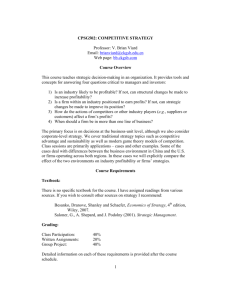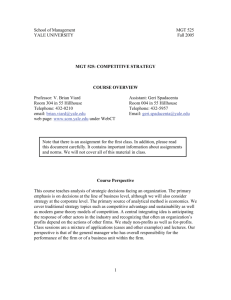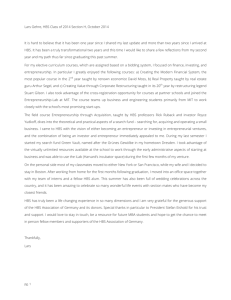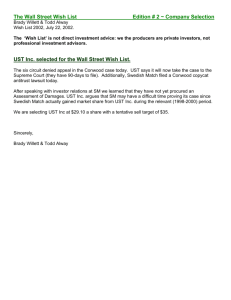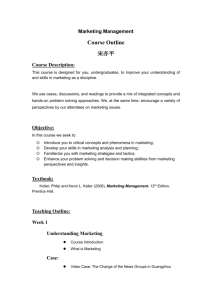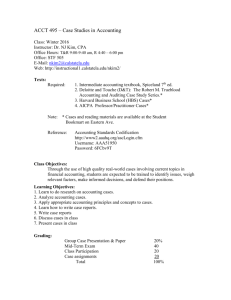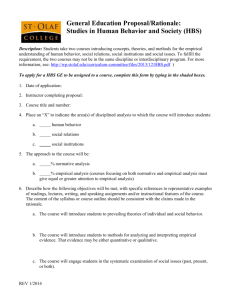Econ 5180: Strategy and Organization
advertisement
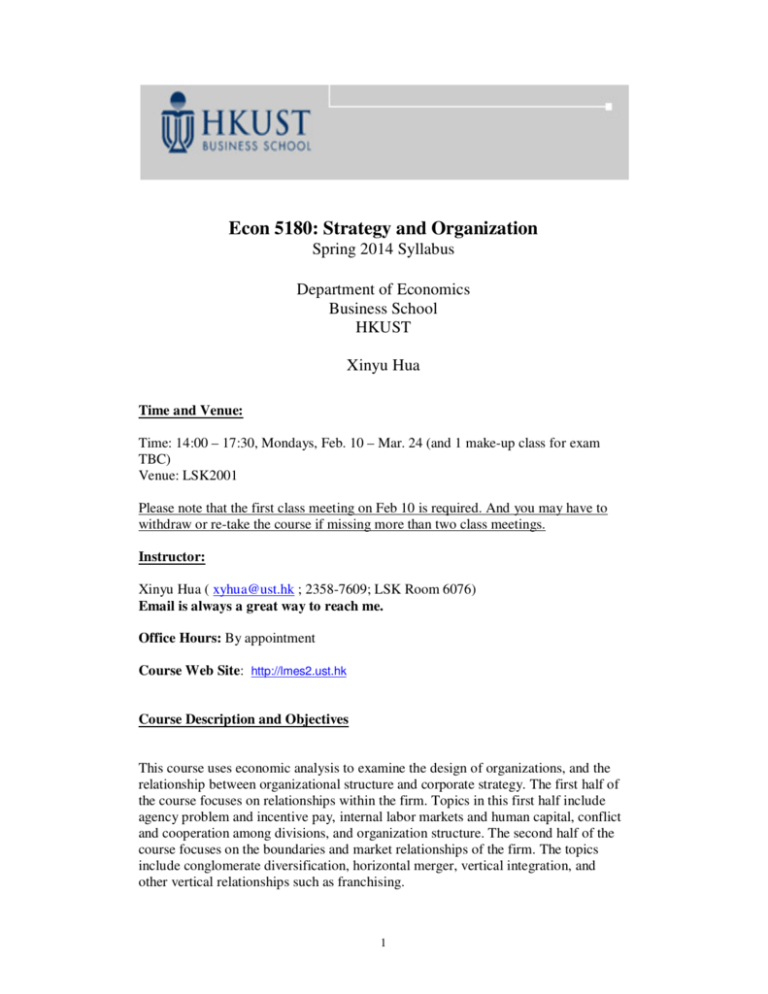
Econ 5180: Strategy and Organization Spring 2014 Syllabus Department of Economics Business School HKUST Xinyu Hua Time and Venue: Time: 14:00 – 17:30, Mondays, Feb. 10 – Mar. 24 (and 1 make-up class for exam TBC) Venue: LSK2001 Please note that the first class meeting on Feb 10 is required. And you may have to withdraw or re-take the course if missing more than two class meetings. Instructor: Xinyu Hua ( xyhua@ust.hk ; 2358-7609; LSK Room 6076) Email is always a great way to reach me. Office Hours: By appointment Course Web Site: http://lmes2.ust.hk Course Description and Objectives This course uses economic analysis to examine the design of organizations, and the relationship between organizational structure and corporate strategy. The first half of the course focuses on relationships within the firm. Topics in this first half include agency problem and incentive pay, internal labor markets and human capital, conflict and cooperation among divisions, and organization structure. The second half of the course focuses on the boundaries and market relationships of the firm. The topics include conglomerate diversification, horizontal merger, vertical integration, and other vertical relationships such as franchising. 1 Brief Course Outline and Pre-Readings The table below gives an approximate outline of the course. Readings can be found on the course site: lmes2.ust.hk Topic Principal-Agent Framework Incentive Contracts Case on “Perellson-Weiner” Week 2 Divisional Relationships Case on “SF Bay Consulting” Week 3 Organization Structure Cases on “Alibaba Group” and “P&G Organization” First Assignment Due: Case analysis and presentation Week 4 Internal Labor Market Week 1 Required reading and preparation before class Conglomerate Diversification Case on “Danaher Corp” Week 5 Horizontal Merger and Acquisition Case on “Coca-Cola and Huiyuan” Week 6 Post-Merger Integration and Implementation Case on “Cisco Systems” Second Assignment Due Vertical Relationship I: Vertical Integration and Market Week 7 Vertical Relationship II: Vertical Integration and Hold-up Week 8 Exam Case on “Pizza Hut” Study Groups and Case Study Method Each group should comprise of no fewer than four but no more than seven people. You are encouraged to form groups by yourselves. The groups are responsible for working on the cases and the group assignments. The approach toward teaching and learning strategy and organization is primarily inductive. That is, you will learn many concepts and topics outlined above largely through cases, examples and some simple models – this is the essence of the case study method. The goal is to carefully study specific business situations and decisions with the goal of extracting broader principles, which will then be available to you in a wide variety of managerial contexts. Good cases are necessarily complex and ambiguous. In preparing for case discussions, you may find sorting through this complexity and ambiguity to be frustrating. The problems presented in the case discussion may not have one correct answer. However, there will generally be a set of insights and solutions which are better than others. And it is in working through the messy details to find these insights and solutions – both in your own preparation and in class discussion – that the concepts and principles introduced in the readings and lectures will come alive and be enriched for you. 2 For a case discussion to be a valuable learning experience, it is essential that you come prepared to discuss the cases assigned for that class. Finally, I ask that you deal with the cases as you find them; do not seek outside or post-case data on the firm or the industry. What Is The Structure Of A Typical Week? Each week we cover some particular topics and cases. 1. Before class: You should read the case and think through answers to each of the case preparation questions before coming to class. I strongly recommend meeting with your group members weekly to go through these questions. 2. In class: I’ll upload soft copies of the lecture notes online. You can take notes on the key insights we are developing, but you won’t need to copy down everything. 3. After class: I’ll distribute the case notes or learning points. It is provided so that you can participate in the discussion rather than take notes. How Will You Be Graded? The grade is made up of four components: 1. Final Exam (50%): The final will be an in-class exam with time to be determined later. It will be a combination of a few mini-case questions and quantitative questions. It is possible that there will be questions about the cases we discussed in class. 2. The First Group Assignment (15%): Some groups will submit written analysis on “Alibaba Group” and the other groups will do so on “P&G Organization” in Week 3 (Feb 24). We will make random draws in Week 1. The report should be in PowerPoint format. During the class, some groups will be selected to make 25 min presentation. 3. The Second Group Assignment (15%): All groups will work on a few questions and submit a short report on “Cisco Systems” in Week 6 (Mar 17). Detailed instructions will be given later. 4. Class Participation and Contribution (20%): Attendance, preparation, and participation are essential in this class, as in any class based on the case method. Obviously, you can not participate if you are not present, so absences without legitimate excuses will lead to a reduced participation grade. Learning opportunities are maximized when students are actively engaged in class discussion. Active engagement means that you’re are listening carefully to the comments of other students and seeking opportunities to make comments that move discussion forward. Class participation will be evaluated primarily on (1) the effort and incentives to prepare and to participate in class discussion, and (2) the evaluation of content based on the following: • Relevance: Are your comments related to the case and to the comments of others? 3 • Advancement: Does your comment move the class discussion forward? • Fact-Based: Have you used specific data from the case, from readings, or from personal experience to support the assertions that you are making? • Logical: Is your reasoning logical? Do you use economic concepts correctly? What Materials Will We Use? Readings: The key materials are the lecture notes, cases, and additional readings. Due to copyright, you should not distribute these materials outside our class for any education or business purpose. The textbook for reference is The Economics of Strategy, 6th Edition, by David Besanko, David Dranove, Mark Shanley, and Scott Schaefer (listed as BDSS below). The book is available in the bookstore on campus. Course Website/Additional Materials: Handouts, additional notes, case preparation questions, and announcements will be posted in the course website under “ECON 5180: Organization and Strategy.” HKUST Academic Integrity and Honor Code The HKUST Academic Integrity and Honor Code apply to this course. The complete text of the Academic Integrity and Honor Code is available on the websites: http://www.ust.hk/vpaao/integrity http://www.ust.hk/vpaao/conduct/good_learning_experience.pps Group Assignment The assignment must be strictly your group’s original work. You may not discuss these assignments with any person other than your group members. You should not use outside industry or company reports regarding the cases. Classroom Etiquette Students are expected to arrive for class on time and the instructor will start and end the class according to schedule. Students should demonstrate respect for the instructor and fellow students during the class period. Please try to avoid side conversations when your classmates raise questions or give comments. You are welcome to bring your laptop or ipad to class in order to take notes or perform calculations on your own computer. However, you may not engage in distracting behavior such as using your laptop to surf the Web, to check e-mail, or to do instant-messaging. For general guidelines about proper classroom behavior, please consult: http://www.ust.hk/vpaao/conduct/good_learning_experience.pps 4 Course Outline This detailed course structure is designed to help you organize what you learn into a coherent framework. However, it is important to recognize upfront that this class can not be as perfectly organized as the outline suggests. This is not accounting or statistics which begin with core, universally accepted principles, and then build to harder problems and applications. Instead, strategy is complicated throughout, and we may adjust the detailed topics or learn new tools throughout the course to answer new questions that arise. Optional Review Readings: • “Economics Review for Strategy”, available online. Weeks 1: a) Introduction b) Principal-Agent Relationship c) Designing Incentive Contracts Case: Perelleson-Weiner (HBS) Reading: BDSS, Chapter 12 (pp. 401-420) Weeks 2: a) Divisional Conflicts and Cooperation Case: SF Bay Consulting (HBS) Reading: BDSS, Chapter 12 (pp. 427-430); Chapter 14 (pp. 470-488) Week 3: a) Organization Structure Cases: Alibaba Group (HBS) P&G Organization 2005 (HBS) Reading: BDSS, Chapter 13 Week 4: a) Internal Labor Market (Human Capital and Dynamic Incentives) Reading: BDSS, Chapter 12 (pp. 421-427) b) Conglomerate Diversification Case: Danaher Corp (HBS) Reading: BDSS, Chapter 2 (pp. 83-92) 5 Week 5: a) Horizontal Merger and Acquisition Case: Coca-Cola and Huiyuan Reading: BDSS, Chapter 2 (pp.61-82) Week 6: a) Post-Merger Integration and Implementation Case: Cisco Systems (HBS) BDSS, Chapter 4 (pp. 132-137) b) Vertical Relationship I: Vertical Integration and Market Reading: BDSS, Chapter 3 Week 7: a) Vertical Relationship II: Vertical Integration and Holdup Case: Pizza Hut (HBS) Reading: BDSS, Chapter 3 6
